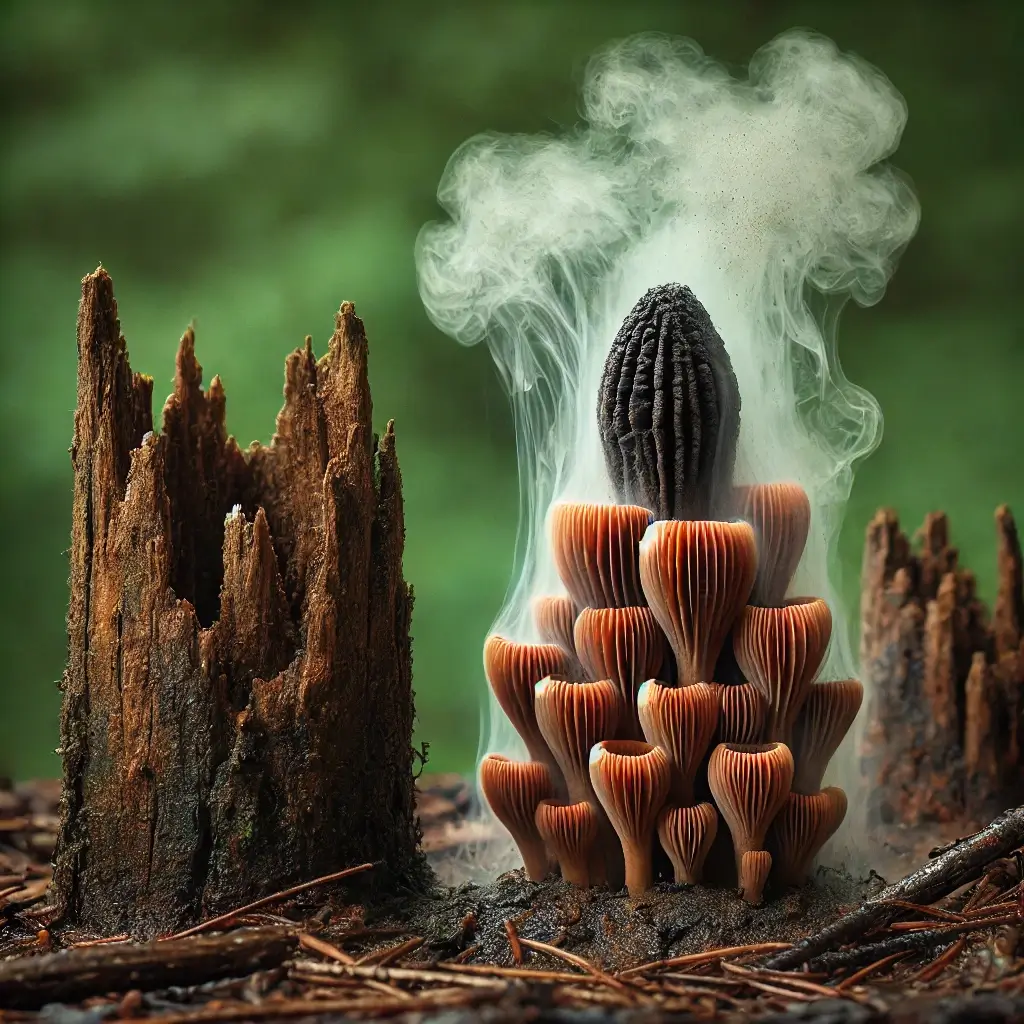Introduction to the Rare Hissing Mushroom
The natural world holds countless mysteries, and among them is the captivating story of the rare hissing mushroom, also known as the Texas Star Mushroom (Chorioactis geaster). Found primarily in North and Central Texas, with rare sightings in Japan and Oklahoma, this fungus is not only an ecological curiosity but also a marvel of nature’s design. Its dark, cigar-like shape belies its ability to transform into a tan, star-shaped structure, earning it the nickname “Devil’s Cigar.”
The Unique Spore Dispersal Mechanism
Unlike most mushrooms, which silently release their spores, the Texas Star makes a dramatic entrance. After rainfall, it unfurls with a distinct hissing sound, emitting a hazy spore cloud that has fascinated mycologists and enthusiasts alike. This peculiar phenomenon results from built-up pressure within the mushroom, showcasing a natural mechanism designed to ensure effective spore dispersal. Despite its rarity, the Texas Star represents a bridge between the fungal world and the broader ecosystem, thriving on decaying cedar elm stumps and playing a vital role in nutrient cycling.
A Symbol of Biodiversity and Adaptation
The rarity of Chorioactis geaster only adds to its allure. Restricted to very specific habitats, it exemplifies nature’s fragility and adaptability. This mushroom’s survival hinges on the delicate balance of its environment—specific soil types, host trees, and climatic conditions. Given its elusive nature, the Texas Star is more than just a mushroom; it is a symbol of biodiversity and the importance of preserving fragile ecosystems. It also serves as a reminder of the hidden wonders that nature offers to those who take the time to look closely.
The Ecological Role of Fungi
Fungal species like the Texas Star contribute significantly to their habitats, breaking down organic material and recycling nutrients. These functions are critical to the health of forests and other ecosystems. Observing such interactions reinforces the importance of fungi in maintaining ecological balance, a role that is often overlooked but essential to biodiversity.
Recent Research on the Hissing Mechanism
Recent studies have delved deeper into the biology and ecological significance of the Texas Star Mushroom. Researchers have discovered that the hissing mechanism serves not only as a spore dispersal method but also as a response to environmental stimuli, such as moisture levels and air pressure changes. A 2023 study published in Mycological Research analyzed spore viability post-release and found that the forceful ejection aids in dispersing spores across greater distances, increasing their chances of germination.
Citizen Science and Conservation Efforts
In 2024, an interdisciplinary research group from the University of Texas initiated a project to map occurrences of Chorioactis geaster using citizen science. By encouraging locals to report sightings through an app, they aim to better understand its distribution patterns and environmental dependencies. This initiative highlights the mushroom’s role in engaging communities with conservation science and building awareness about fungal biodiversity.
International Presence and Biogeographical Patterns
The mushroom’s international presence, particularly in Japan, has sparked discussions about biogeographical patterns and fungal migration. Comparative DNA studies suggest that populations in Japan and Texas diverged millions of years ago, possibly due to continental drift. Such insights not only shed light on fungal evolution but also underscore the interconnectedness of global ecosystems. Additionally, researchers are exploring how these unique fungi adapt to their respective environments, focusing on genetic factors that contribute to their survival in disparate regions.
Symbiotic Relationships in the Fungal World
One notable finding from recent research involves the symbiotic relationships that Chorioactis geaster forms with surrounding plants and microorganisms. These interactions are believed to influence the mushroom’s growth and reproductive success. Understanding these dynamics provides valuable insights into how fungi contribute to ecosystem health and resilience, emphasizing their role as keystone species in their habitats.
The Importance of Fungal Conservation
The rare hissing mushroom, with its dramatic appearance and unique life cycle, offers more than just a spectacle. It serves as a reminder of the intricate relationships within ecosystems and the importance of conservation. As researchers unravel its mysteries, Chorioactis geaster continues to inspire awe and curiosity, standing as a testament to nature’s ingenuity and resilience. Moreover, its presence in both Texas and Japan underscores the interconnectedness of global ecosystems and the need for collaborative conservation efforts.
Respecting and Protecting Natural Wonders
For anyone lucky enough to encounter this marvel, remember: admire it from afar. Its delicate nature and ecological importance demand our respect and protection, ensuring that future generations can marvel at this rare gem of the fungal world. By fostering an appreciation for such unique species, we take a step toward preserving the biodiversity that sustains life on Earth.
Scientific References
“Spore Dispersal Mechanisms in Chorioactis geaster,” Mycological Research, 2023.
University of Texas Citizen Science Project on Fungal Biodiversity, 2024.
“Biogeographical Analysis of Chorioactis Populations,” Journal of Fungal Evolution, 2022.
“Symbiotic Interactions in Rare Fungal Species,” Ecological Mycology, 2021.
